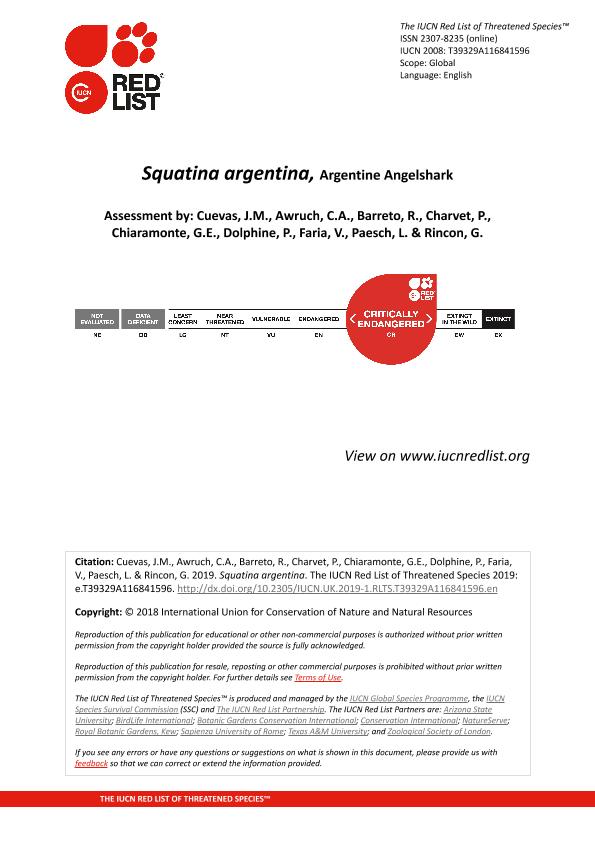Artículo
Squatina argentina, argentine angelshark
Cuevas, J. M.; Awruch, Cynthia Andrea ; Barreto, R.; Charvet, P.; Chiaramonte, Gustavo Enrique
; Barreto, R.; Charvet, P.; Chiaramonte, Gustavo Enrique ; Faria, V.; Paesch, L.; Rincon, G.
; Faria, V.; Paesch, L.; Rincon, G.
 ; Barreto, R.; Charvet, P.; Chiaramonte, Gustavo Enrique
; Barreto, R.; Charvet, P.; Chiaramonte, Gustavo Enrique ; Faria, V.; Paesch, L.; Rincon, G.
; Faria, V.; Paesch, L.; Rincon, G.
Fecha de publicación:
12/2020
Editorial:
International Union for Conservation of Nature
Revista:
The IUCN Red List of Threatened Species
ISSN:
2307-8235
e-ISSN:
2307-8235
Idioma:
Inglés
Tipo de recurso:
Artículo publicado
Clasificación temática:
Resumen
The Argentine Angelshark (Squatina argentina) is a small (to 138 cm total length) demersal shark species that occurs in waters in the Southwest Atlantic from Santa Catarina, Brazil, south to Buenos Aires, Argentina. This species inhabits sandy substrates at depths of 51-320 m. The species has a relatively slow life history, giving birth to 7-11 pups with a biennial or possibly triennial reproductive cycle. The Argentine Angelshark is targeted and/or caught as bycatch in demersal trawl, gillnet, and longline fisheries, and is sold and utilized for human consumption (although angel sharks are protected in Brazil). Angel sharks are notoriously difficult to identify, and catches are typically reported at the generic level and therefore include at least three species that are native to the region (the Argentine Angelshark, the Hidden Angelshark (S. occulta), and the Angular Angelshark (S. guggenheim)). Declines in CPUE during research trawls in southern Brazil indicate that the population declined substantially in the mid-late 1990s. Further research data corroborates this, indicating the equivalent of a reduction of more than 90% over three generation lengths (46.5 years). There is also heavy fishing pressure in Uruguay and Argentina, where the Argentine Angelshark is caught alongside the Hidden Angelshark and the Angular Angelshark. Landings data indicate a reduction of angel sharks in the Argentinean-Uruguayan Common Fishing Zone of over 70% over three generations, and datasets further south in Argentina indicate a reduction of over 90% over a similar timeframe (although these landings likely consist mostly of Angular Angelshark). Due to heavy fishing pressure across its range, reported declines in landings and research surveys, and the species' low productivity, it is inferred that this species has undergone, on balance, a population reduction of at least 80% over the past three generations (46.5 years). Therefore, the Argentine Angelshark is listed as Critically Endangered A2bd. Strict regulations for limits to fisheries catch are needed, as is the identification and protection of critical habitat.
Palabras clave:
Chondrichthyes
,
Squatiniformes
,
Squatinidae
,
Argentine Angelshark
Archivos asociados
Licencia
Identificadores
Colecciones
Articulos(MACNBR)
Articulos de MUSEO ARG.DE CS.NAT "BERNARDINO RIVADAVIA"
Articulos de MUSEO ARG.DE CS.NAT "BERNARDINO RIVADAVIA"
Citación
Cuevas, J. M.; Awruch, Cynthia Andrea; Barreto, R.; Charvet, P.; Chiaramonte, Gustavo Enrique; et al.; Squatina argentina, argentine angelshark; International Union for Conservation of Nature; The IUCN Red List of Threatened Species; 12-2020; 1-14
Compartir



